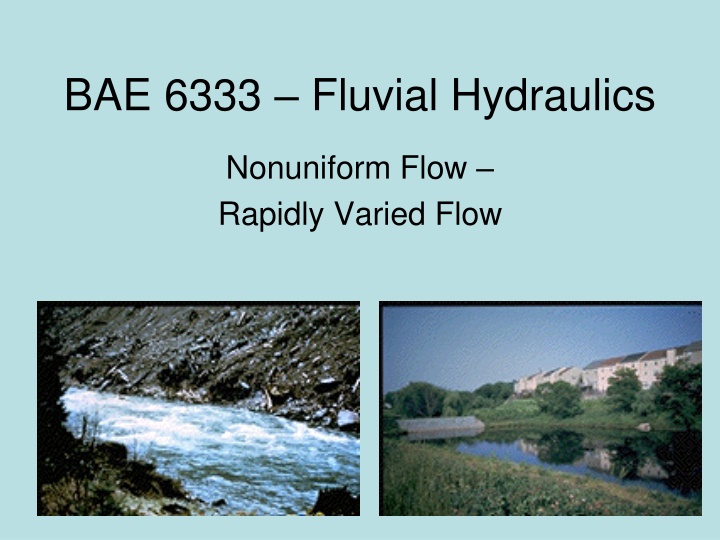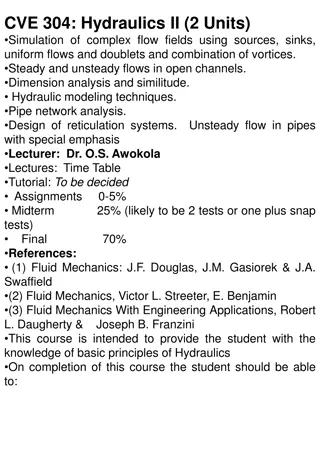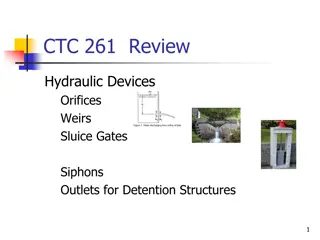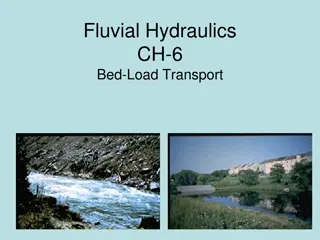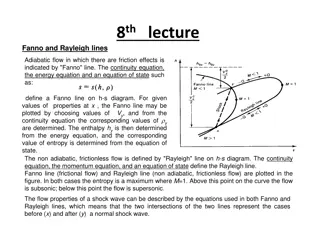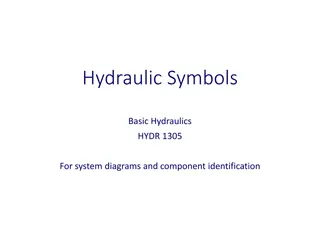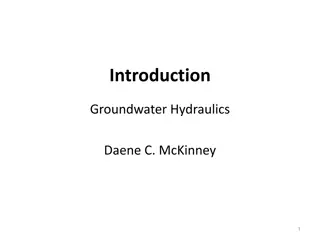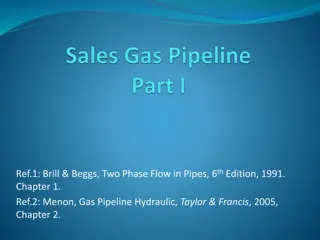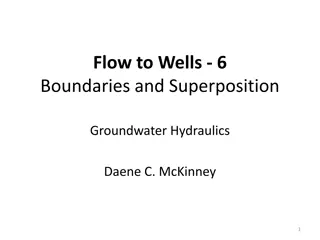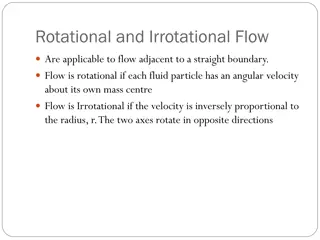Fluvial Hydraulics: Nonuniform and Rapidly Varied Flow
This content delves into the intricacies of fluvial hydraulics, focusing on nonuniform flow patterns and rapidly varied flow phenomena. It addresses the challenges in predicting flow profiles for gradually varied flow up to critical depth and examines the use of weirs and spillways to control discharge in channels. Through visual aids and detailed explanations, the content explores hydraulic drops, critical depths, and discharge equations for different hydraulic structures such as broad-crested weirs and Parshall flumes or Venturi canals.
Download Presentation

Please find below an Image/Link to download the presentation.
The content on the website is provided AS IS for your information and personal use only. It may not be sold, licensed, or shared on other websites without obtaining consent from the author.If you encounter any issues during the download, it is possible that the publisher has removed the file from their server.
You are allowed to download the files provided on this website for personal or commercial use, subject to the condition that they are used lawfully. All files are the property of their respective owners.
The content on the website is provided AS IS for your information and personal use only. It may not be sold, licensed, or shared on other websites without obtaining consent from the author.
E N D
Presentation Transcript
BAE 6333 Fluvial Hydraulics Nonuniform Flow Rapidly Varied Flow
Thus farAnd now beyond Ability to predict flow profile for gradually varied flow up to hc Rapidly Varied Flow downstream of critical depth over a short stream length Supercritical to Subcritical Subcritical to Supercritical Implicit assumption from before of a hydrostatic pressure distribution is no longer valid
Rapidly Varied Flow Weirs and Spillways used to control the discharge in a channel
Rapidly Varied Flow Weirs and Spillways used to control the discharge in a channel Discharge equations usually based on energy equations with discharge coefficient (KD) See Equation 4.32 (small approach velocity) 2 = 2 Q L K H gH D D 3 Graf presents empirical relations for: Sharp-crested weirs Spillways Mobile spillways (gate)
Rapidly Varied Flow Hydraulic Drop M2 or H2 profile Flow is subcritical upstream of the drop Critical depth is the smallest possible flow depth for a given discharge: Because of flow being rapidly varied (not hydrostatic), critical depth (hc) occurs just upstream of the drop Depth at section of drop (hb): 2 q = = . 0 72 . 0 72 h h Rectangula r 3 g b c = . 0 75 h h Non Rectangula r b c
Rapidly Varied Flow Hydraulic Drop Broad-Crested Weir: Weir can be assimilated to a short rectangular channel with a hydraulic drop Critical depth occurs just upstream of the drop Discharge equation: = = K Q L q L K h gh D D D c c . 0 88 . 0 98 D
Rapidly Varied Flow Hydraulic Drop Parshall Flume or Venturi canal: Vertical and/or horizontal constriction (throat) in a channel (rectangular) followed by a progressive enlargement Geometry must allow for hcsomewhere in throat Discharge equation: Q = 3 c B gh 2
Rapidly Varied Flow Hydraulic Drop Parshall Flume or Venturi canal: Difficulty with this equation is predicting (accurately) the location of hc Usually expressed as function of upstream flow depth (h1) 3 2 = Q K B g h 2 1 j 3
Rapidly Varied Flow Underflow Gates used for measuring flow in a channel or controlling discharge leaving a reservoir Usually vary Aofor needs of hydraulic engineer (vary Q) Most common type is the sluice gate
Rapidly Varied Flow Underflow Gates Discharge equation based on energy equation before and after the gate: ( 1 2 h h g K A Q v o = ) = 2 A K gh 2 1 o v See Equation 4.38 for gate coefficient (Kv)
Hydraulic Jump Step change in depth from shallow to deep without change in channel cross-section Jump actually discontinuity in water surface profile (dy/dx = )
Hydraulic Jump in Rectangular Channel Consider a horizontal, rectangular section after a spillway (Note that y = h and V = U):
Hydraulic Jump in Rectangular Channel Assume that we can identify two sections (1, 2) where flow is uniform outside the complexities of the jump Neglect shear stresses (friction) because we are going to take points 1 and 2 close together Momentum: ( ) ( ) = = F F Q U U U h b U U 1 2 2 1 1 1 2 1
Hydraulic Jump in Rectangular Channel Pressure forces are assumed hydrostatic (momentum): h U h h = 2 2 2 ( ) 1 1 g 1 U U 2 1 2 2 Considering conservation of mass: h bU h = 1 1 = bU Q 2 2 Considering energy with head loss due to turbulence: U h + 2 2 2 2 U 2 = + + 1 h L h 1 2 g g
Hydraulic Jump in Rectangular Channel SOLUTIONS: = = = 0 h h U U L h 1 2 1 2 ) ( 2 8 gh h q h = + + = + + 2 1 1 1 1 8 1 1 h Fr 2 1 3 1 2 2 ) ( 2 8 gh h q h = + + = + + 2 1 1 1 1 8 2 2 h Fr 1 2 3 2 ( 2 2 ) 3 h h h = 2 4 h 1 hL 1 2
Hydraulic Jump in Rectangular Channel Actual structure of a hydraulic jump depends on the Froude number: Five Types of Surface and Jump Conditions: 1. Standing Wave Energy Dissipated <5% 2. Weak Jump Energy Dissipated 5-15% 3. Oscillating Jump Energy Dissipated 15-45% 4. Steady Jump Energy Dissipated 45-70% 5. Strong Jump Energy Dissipated 70-85%
Hydraulic Jump in Rectangular Channel
